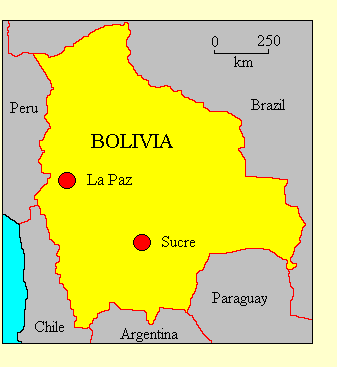

PLURINATIONAL STATE OF BOLIVIA
• Official name: Plurinational State of Bolivia (Estado Plurinacional de Bolivia)
• Location: South America
• International organisations: Andean Community, Non-Aligned Movement, Organisation of American States, United
Nations, World Trade Organisation
• Borders: Argentina, Brazil, Chile, Paraguay, Peru
• Coastline: None
• Land area: 1,098,580 Km2
• Population: 9,900,000
• Annual GDP (PPP) per capita: US$4,600 (2009 CIA estimate). World ranking: 116
• Ethnicity: The majority of the population is of Amerindian descent, the largest
populations being Quechua (30%) and Aymara (25%). Another 30% are mestizos (mixed
European and Amerindian ancestry). Only about 15% are of wholly European (mainly
Spanish) descent.
• Languages: Spanish, Quechua and Aymara are official languages. In practice
Spanish is the language of government, business and communication. About 30% of the
population speak Amerindian languages as their first language.
• Religion: 95% of the population are Catholic Christians. There is a small
Protestant minority. Indigenous religious practices survive among the Amerindian
population.
• Form of government: Presidential democratic republic. Bolivia is divided into
nine departments.

• Capital: Sucre is the official capital and the seat of the judiciary. La Paz is the seat of government.
• Constitution: The new
Constitution of the Plurinational State of Bolivia came into effect on 7 February 2009 (not yet available
online in English).
• Head of state: The President, elected by direct universal suffrage for a five-year term.
• Head of government: The President, who appoints all ministers.
• Legislature: Bolivia has a bicameral legislature, the
National Congress (Congreso Nacional).
The Chamber of Deputies (Camara de Diputados) has 130 members, elected for
five-year terms by proportional representation. (Under the new constitution they will be elected from single-member
constituencies.) The Chamber of Senators (Camara de Senadores) has 27 members, elected for five-year terms by proportional
representation. (Under the new constitution there will be 36 Senators.)
• Electoral authority: The Supreme Electoral Tribunal
administers national elections.
• Freedom House 2011 rating: Political Rights 3, Civil Liberties 3
• Transparency International Corruption Index: 28% (110 of 178 countries rated)
• Reporters Without Borders Press Freedom 2010 Index: 71.9% (103 of 178 countries rated)
• Heritage Foundation Economic Freedom 2010 Index: 50.0% (147 of 178 countries rated)
Political history
The area which is now Bolivia was part of the empire of the Incas when the Spanish arrived
in the early 16th century. The area, then known as Alto Peru, was governed from Lima until 1776,
when it was transferred
to the jurisdiction of Buenos Aires. Independence was declared as early as 1809, but was not
secured until the battle of Ayacucho in 1824. In 1825 Alto Peru was renamed Bolivia in honour
of Simon Bolivar.
After ten years of dictatorial rule by General Andres de Santa Cruz, Bolivia descended
into many decades of political instability. Politics was dominated by a small European elite who
excluded the Amerindian majority. There were frequent coups and transient constitutions.
Bolivia fought disastrous wars against Chile and Paraguay. There was an attempted socialist
revolution in 1936, and a briefly successful one in 1943, when the Nationalist Revolutionary
Movement (MNR) held power for three years.
A conservative regime held power until 1952, when another revolution restored the
MNR under Victor Paz Estenssoro to power. The MNR regime gave the Amerindian population
the vote, and free elections were held in 1956 and 1960. In 1964 Estenssoro was ousted by an
army coup, and Bolivia was ruled by a succession of military regimes for the next 20
years. In 1982 democratic goverment was restored, and Estenssoro was re-elected President
in 1985.

Although the army ceased interfering in Bolivian politics during the 1990s, the country's internal
class and ethnic conflicts increased. In 2003, a right-wing president, Gonzalo Sanchez de Lozada, was
forced out of office by a workers' rebellion, and in 2005 the leader of the indigenous working class,
Evo Morales,
was elected president. In the teeth of fierce opposition, he introduced a new constitution that makes Bolivia a secular,
centralised and "plurinational" state, and nationalises the country's natural resources. Critics say Morales is trying to emulate Fidel
Castro, but despite periodic disturbances democratic instututions do not so far seem to be under threat. Morales survived an attempt to
recall him in 2008, and was comfortably re-elected in December 2009, also winning control of both houses of the Congress.
The MNR lost its position as Bolivia's leading left-wing party in the 1990s. It has been replaced by
President Morales's Movement for Socialism (MAS), which won control of the Congress
in 2005. The leading conservative party is the Nationalist Democratic Alliance (AND),
also called Social and Democratic Power (PDS).
Freedom House's 2011 report on Bolivia
says: "Bolivia is an electoral democracy. Elections and referendums since 2005 have been deemed free and fair by
international observers... Corruption and nepotism remain common vices in Bolivia. In March 2010, major new anticorruption
legislation passed into law, promising a more rigorous institutional framework to combat graft...
Although the constitution guarantees freedom of expression, the media are subject to some limitations in practice...
Bolivian law provides for the rights of peaceful assembly and freedom of association... Despite some governmental
efforts to hasten reform, the judiciary remains corrupt, inefficient, and inaccessible to many Bolivians...
Both the human rights ombudsman and independent human rights organizations are able to report on violations committed
by the security forces, although impunity remains the norm."
Updated October 2011
|


